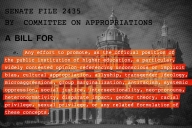You have /5 articles left.
Sign up for a free account or log in.
Every fall, the College Board releases reports on prices to attend college and the availability of aid to pay for college. Inside Higher Ed is among the many publications that write about the reports and cite their data throughout the year.
Last week 14 Democratic senators wrote the College Board to urge it to make changes in the way it calculates expenses faced by students, and the way it presents the data. In some instances, the letter said, the presentation fails to portray the real costs faced by students, especially at community colleges. The senators were led by Senator Brian Schatz of Hawaii. Those signing the letter include four senators running for president: Kamala Harris of California, Amy Klobuchar of Minnesota, Cory Booker of New Jersey and Kirsten Gillibrand of New York.
The letter faults the College Board first for its descriptions of costs beyond tuition and room and board. The letter notes that the report on prices states "that books, supplies, and transportation 'are not really additional costs associated with attending college, but are expenses people face whether or not they are in school.' We believe this is inaccurate based on a number of studies showing that living costs are often higher, not lower, for people enrolled in college. Moreover, people who are not enrolled in college do not have to purchase textbooks and course materials on a regular basis, so it is not accurate to assume these are insignificant or everyday expenses."
The issue of book and material expenses is typically most dramatic to community college students since their tuition rates are lower than are those of four-year college students. And as many districts and a few states have made community college tuition-free, these expenses may be the most significant ones faced by students.
The letter also says that parts of the College Board's analysis on community college pricing give a false sense about the impact of these prices on various students. This is a case, the letter says, where averages may not convey the full reality.
"The net price statistics used in the College Board’s reports also mischaracterize the aid that is likely to be received," the letter says. "'Trends in College Pricing' states that, for the average community college student, 'grant aid and tax benefits cover all of the tuition and fees.' The net price page and tables use a 'net tuition and fees' figure of negative $390, which implies that students receive more aid than the cost of attendance or earn money by attending community college. While community colleges are often high quality, affordable options for students, research shows that many community college students still take on debt to cover costs."
There are several problems with this, the letter says. "First, community college prices are inherently local and vary widely state by state. National averages obscure that reality. Second, tax benefits (arriving in the spring, at the earliest) are not available when college bills are due. Data also show that tax benefits for higher education are skewed toward wealthier students compared to both enrolled students and the general population. Third, the report makes inappropriate assumptions about the "average" community college student. This is a diverse population that includes many students who are deemed ineligible for the Pell Grant but still have unmet financial need."
In fairness to the College Board, it should be noted that one page of its report (page 14 from this link) does include state averages for community college tuition and fees. And that page does show that the national average is more than twice the average for California, the state with the lowest average, and less than half the average for Vermont, the most expensive.
A spokeswoman for the College Board said via email that officials there were "reviewing the feedback from the senators and will be back in touch with their offices."
This is the second time Senator Schatz and Democratic colleagues have focused on information available to prospective college students. In December, they wrote to the editors of U.S. News & World Report, arguing that the rankings methodology does not do enough to highlight colleges that admit large numbers of disadvantaged students.








